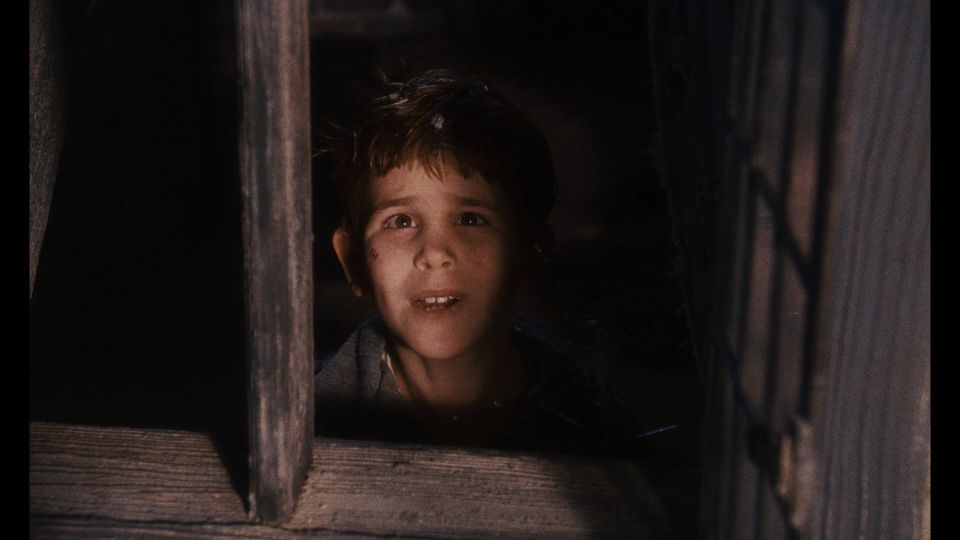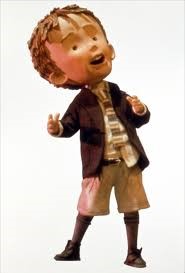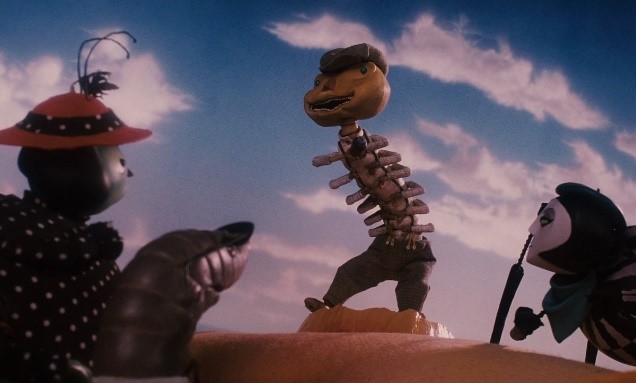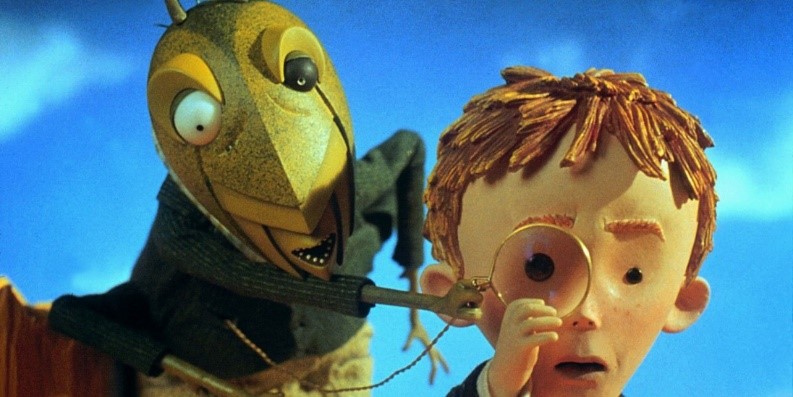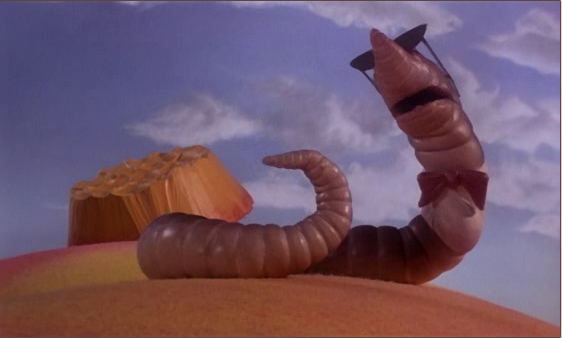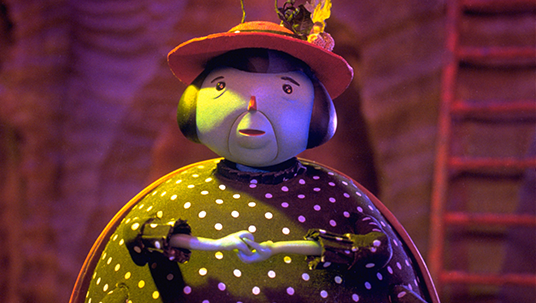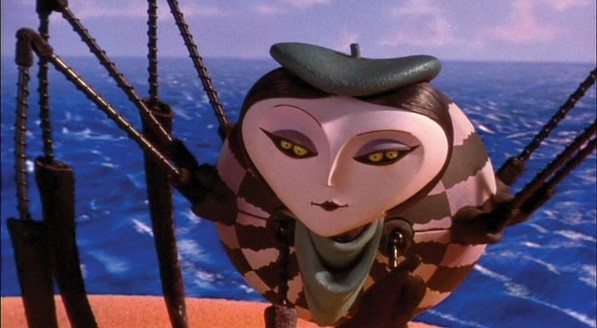Overcoming Stereotypes and Nightmares: How You can Find Help from the Smallest of Friends
Based on the children’s book by Roald Dahl, James and the Giant Peach focuses on a boy named James Trotter. James is first introduced with his parents, dreaming of one day heading over to New York City from England. But tragedy strikes when his parents are killed by a storm that is represented as a rhino, and now has to live with his horrible, and abusive aunts. James’s life seems bleak until he’s handed magical crocodile tongues, which he accidentally drops on the ground. But due to their magic they make a tree sprout a peach that keeps growing and growing until it’s as large as his house. James escapes from is aunts into the peach where he meets a centipede, a spider, a grasshopper, a silkworm, an earthworm, and a ladybug, who have all been affected by the magic making them human sized and can talk. They all have the goal to escape to a perfect world and James claims that they can find it in New York City. Through their misadventures, James finds true friends can be found in the smallest of places and he can overcome any obstacle if he puts his mind to it
Translating Roald Dahl’s work onto the big screen posed a difficult issue of how to mix real life with this weird fantasy he created. Unfortunately, He never got to see his work on the big screen, but his widow Felicity was impressed with Director Henry Selick’s adaptation, that she approved (Jackson, 1996). Selick was able to bridge reality and fantasy by having his film switch between live-action and stop motion animation. The production team was very keen on making sure that the stop-motion aspect of the film was made as magical as possible, by filming the live-action sequences very muted and stylized, almost like it was being filmed on a stage (Jackson, 1996). This style also allowed the film to easily “shift in and out of reality and dream, creating an occasionally surreal, occasionally creepy, occasionally reassuring experience” (Ness, 2013). This also allowed the human-sized insects to have more characteristic depth, giving them ability to talk and have a subconscious.
Insects are predominately not the most popular of creatures to encounter for most humans. In most instances when a person sees a spider, their initial reaction is to reach for the fly swatter and kill it. Director Selick uses stop-motion to animate the insects in a way so they can show there is more than meets the eye. And throughout the film we see these insects defy their assumed stereotypes.
The Centipede
Usually imagined crawling in the dark and infesting people’s households. Their one hundred legs creepy enough to make a person’s skin crawl. They’re considered pests, and no one wants them around. The Centipede in James and the Giant Peach accepts that he is a pest; embraces it even. He lives up to his stereotype by annoying everyone (especially Miss Spider) and getting into trouble. But there is more to this arthropod than meets the eye, such as he has forty-two legs instead of one hundred. He also proved that he is more than jokes and tricks by risking his life to help everyone else. When the crew became lost in what looks like an ice-covered sea graveyard, he attempts to redeem himself by searching for a compass. Even if that meant diving into the freezing waters and going aboard a skeleton filled pirate ship. And then he risked his life for Miss Spider and James by turning back to fight off the skeleton pirates so that they can get away. He managed to make it out without a scratch, and after that everyone’s view of him changes from being a pest, to being a hero.
The Old Green Grasshopper
Grasshoppers are not usually viewed as disturbing as some of the other bugs in the film. But most people when thinking of the insect, usually just think they make the chirpy sounds at night. James mentions this to Grasshopper and he becomes offended by that saying that’s cricket noises, and he is more musically intuitive. He plays the violin so beautifully that at the end of the film, he makes it into the New York Symphony Orchestra. He also reminds James that even though he doesn’t have his parents, that the bugs are with him even if they are an odd family. However, he does fall victim to judging characters based on their known stereotype. Whenever he interacted with Centipede he always treated him as inferior and a pest. But after Centipede saved everyone Grasshopper apologized for how he acted towards him.
The Earthworm
Probably the character that doubts himself the most of all, Earthworm doesn’t find a place for himself anywhere but in the dirt. Just as most people see worms, wiggling around and eating dirt, and, like Centipede, he believes it. But James is able to convince him otherwise mentioning how helpful he really is. When trying to attract the seagulls to lift the peach out of the water, they used Earthworm to entice the gulls to come down close enough to capture them. James also settles all of Earthworm’s fears by saying to look at his problems in a different, more positive perspective. Earthworm later repeats that same advice to James when he is facing the rhino.
The Ladybug
This character falls victim to the literal translation of her name. As a ladybug, she is very proper looking, wearing a dress and carrying her purse, and she is very proper attitude wise, like the bug version of Mary Poppins. She’s very sweet and looks almost helpless, but don’t let that fool you. When the crew was trying to escape from the mechanical shark, it released smaller sharks that ended up cutting some of the gulls loose. Grasshopper and James both try to go after the gulls, but the shark then releases more, smaller mechanical sharks. Grasshopper and James are helpless but then Ladybug springs into action knocking the sharks out of the way and saving Grasshopper and James.
Miss Spider
Probably the one insect that is detested most of all, spiders are seen as creepy and are sometimes a symptom of nightmares. Even to other insects, they are something to fear since they are predators in the insect world. When we are first introduced to Miss Spider, she reassures James that no one will eat him but then Centipede interjects joking that she’ll just suck his blood out. While that is truly what spiders do, it makes Miss Spider out to be some carnivorous monster. And like Centipede and Earthworm she is indifferent about it stating, “it is in their nature to have fear of me, this I cannot change.” But we see throughout the film she is nothing like she’s made out to be, helping James and acting almost like a mother-figure to him.
The insects portray an important role in overcoming stereotypes and help James overlook his anthropocentric view of the world. Where “he fails to consider any perspective other than his own” (Rambler, 2015) and usually accepts what is universally accepted instead of questioning anything. James only thought the grasshoppers can only make cricketing noises, but he finds that the Old Green Grasshopper can actually play the violin beautifully. Also, James at first assumes the Centipede has one hundred legs because it’s what is the widely accepted fact of them (it is what their name translates to); however, it’s revealed later that Centipede actually has forty-two legs. This anthropocentric view can be derived from a lack of critical thinking (Rambler, 2015), which could have arisen due to living with his aunts. When James was with his parents, he was encouraged to look at the world differently as seen when they were gazing at the clouds. But when he moved in with his aunts, they discouraged him from questioning anything and ‘daydreaming’ causing him to shy away from seeing things differently. James’ adventure with the bugs allows him to discover that while there are popular conceptions of a person or animal, it doesn’t mean that they’re all the same.
While James is challenged with the task of overcoming stereotypes, he also faces animal-like antagonists during the film. One of them maybe the most crucial of the enemies James faces, the rhino is introduced very early in the film as the reason James’ parents died. From when it’s first mentioned, it’s hard to comprehend whether an actual rhino had killed his parents, or that there was a storm that in James’ eyes was like a rhino. But why a rhino? Maybe it’s because when one thinks of a rhino charging, they imagine extreme power and it has the ability to strike fear into a person. And looking at the storm, it appears very frightening and strong. One could look at it as James’ inability to control his environment. Nature can be very unpredictable and can have the tendency to cause death. James’ fear over the rhino can mean that since it’s such a strong, uncontrollable force he will always be in fear of it. But in the end, he handles it like how a kid would handle their own nightmares, saying it isn’t real.
James’ interaction with the rhino demonstrates the forces that he is unable to control but can still overcome. The rhino represents James’ environment, both socially and naturally. While living with is aunts, they would always threaten to throw him to the rhino if he misbehaved. It was their way to easily control him with fear. Because of that, James listened to every wish that his aunts had him do so he wouldn’t anger the rhino. Looking at his natural environment, the rhino is an actual storm, which is something that is impossible to control. But instead of a physical enemy, it posed more so a childish nightmare like a fear of thunder or the dark. Because of the intensity of the storm, he compares it to a rhino and while he cannot physically defeat it, he can rise above his fear of it.
Director Henry Selick’s depiction of Roald Dahl’s book, James and the Giant Peach, was greatly transformed from its literary pages to the big screen. It’s transition from live-action to stop-motion most certainly made the experience magical and surreal. A classic Disney film filled with plot filling musical numbers and a happy ending. It put a misunderstood boy into a world where he had to realize that there were creatures that he misunderstood. In order to overcome what people thought of him, he had to realize his own faults of judging others. He also had to conquer his nightmare that kept him in a prison. Overcoming his fear of the rhino, he was able to break free from his physical prison with his aunts, and his mental prison of always being in fear of thunderstorms.
Readings
Jackson. W. (1996). Peaches N’ Dreams: Henry Selick’s James and the Giant Peach. Animation World Magazine. [online] Volume 1. Available at: https://www.awn.com/mag/issue1.2/articles1.2/jackson1.2.html [Last Accessed: 20 May 2018]
Ness. M. (2013). Reality, Dream and Animation: James and the Giant Peach. [Blog] Tori.com. Available at: https://www.tor.com/2013/03/28/reality-dream-and-animation-james-and-the-giant-peach/ [Last Accessed: 20 May 2018]
Rambler. (2015). Roald Dahl’s James and the Giant Peach: Ecocriticism for Children. [Blog] Literary Ramblings. Available at: http://www.literaryramblings.com/1000-books-in-10-years-vol-418-james-and-the-giant-peach-by-roald-dahl [Last Accessed: 20 May 2018]
